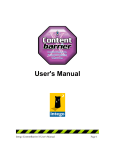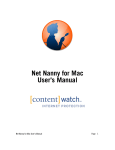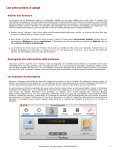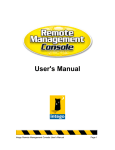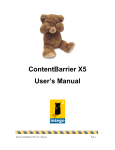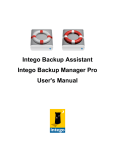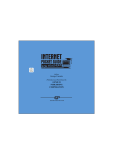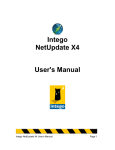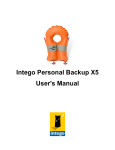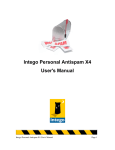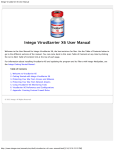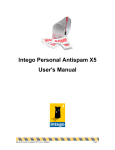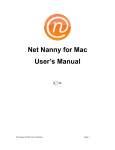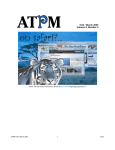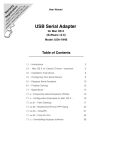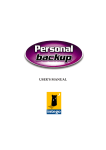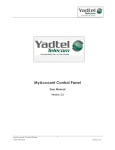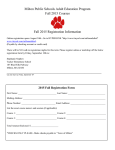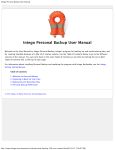Download ContentBarrier User`s Manual
Transcript
ContentBarrier User's Manual ContentBarrier User's Manual Page 1 ContentBarrier for Macintosh ©2001 - 2002 Intego, Inc. All Rights Reserved Intego, Inc. www.intego.com This manual was written for use with ContentBarrier software for Macintosh. This manual and the ContentBarrier software described in it are copyrighted, with all rights reserved. This manual and the ContentBarrier software may not be copied, except as otherwise provided in your software license or as expressly permitted in writing by Intego, Inc. The Software is owned by Intego and its suppliers, and its structure, organization and code are the valuable trade secrets of Intego and its suppliers. The Software is protected by United States Copyright Law and International Treaty provisions. ContentBarrier User's Manual Page 2 Contents 1- About ContentBarrier .....................................................................................................5 What is ContentBarrier? .............................................................................................................6 ContentBarrier's Features .......................................................................................................................7 2 - Filtering Internet Content .............................................................................................8 A Brave New World.....................................................................................................................9 Types of Internet Content.....................................................................................................................10 Filtering Content....................................................................................................................................10 How You can Help your Children Surf Responsibly.......................................................................11 Filtering Content in Businesses ..............................................................................................12 Optimizing Productivity ......................................................................................................................12 Optimizing Bandwidth.........................................................................................................................12 Protecting Your Company....................................................................................................................13 3 - Installation ...................................................................................................................14 System Requirements ...............................................................................................................15 Installing ContentBarrier .........................................................................................................15 Custom Installation ...................................................................................................................16 Registering ContentBarrier ......................................................................................................17 Uninstalling ContentBarrier ....................................................................................................18 Uninstalling NetUpdate .......................................................................................................................18 4 - Using ContentBarrier...................................................................................................19 Using ContentBarrier ................................................................................................................20 Opening ContentBarrier .......................................................................................................................20 Managing Users..........................................................................................................................22 Mac OS Multiple Users .........................................................................................................................22 Creating New Users ..............................................................................................................................23 Editing Users ..........................................................................................................................................24 Deleting Users ........................................................................................................................................25 Activating the Current User.................................................................................................................25 Logging In ...................................................................................................................................26 Setting User Restrictions ..........................................................................................................28 Filtering Method ....................................................................................................................................28 Using Selected Filters ............................................................................................................................28 Predefined Settings................................................................................................................................29 Saving Filter Sets....................................................................................................................................29 Editing Filter Sets...................................................................................................................................31 Adding Custom Filters..............................................................................................................32 Editing Custom Filters ..........................................................................................................................35 Deleting Custom Filters ........................................................................................................................36 ContentBarrier User's Manual Page 3 Using Special Sites ....................................................................................................................36 Selecting Special Sites............................................................................................................................ 37 Adding Special Sites..............................................................................................................................38 Removing Special Sites .........................................................................................................................39 Using Special Applications......................................................................................................40 Adding Special Applications ...............................................................................................................41 Removing Special Applications...........................................................................................................41 Internet Access............................................................................................................................42 Setting Time Restrictions ......................................................................................................................43 Redirecting Searches .............................................................................................................................45 Adding Redirection Sites......................................................................................................................46 Removing Redirection Sites .................................................................................................................47 Locking Internet Access........................................................................................................................48 Using the Log..............................................................................................................................49 How the Log works...............................................................................................................................49 Understanding the Log.........................................................................................................................50 Accessing Sites in the Log ....................................................................................................................52 Sorting the Log.......................................................................................................................................52 Clearing the Log.....................................................................................................................................53 Exporting the Log ..................................................................................................................................53 Statistics...................................................................................................................................................54 Clearing Statistics ..................................................................................................................................55 AntiPredator................................................................................................................................56 Adding Filters ........................................................................................................................................57 Editing Filters .........................................................................................................................................58 Deleting Filters .......................................................................................................................................59 Using the ContentBarrier Control Strip Module.................................................................60 Getting Help ...............................................................................................................................62 5 - ContentBarrier Settings...............................................................................................63 The Settings Panel .....................................................................................................................64 Using a Password with ContentBarrier..............................................................................................64 Creating a Password .............................................................................................................................65 Password Options.................................................................................................................................. 66 Log Options ............................................................................................................................................69 E-mail Notification ................................................................................................................................70 Choosing a Startup User.......................................................................................................................71 NetUpdate ..............................................................................................................................................72 Special Sites ................................................................................................................................73 Special Applications..................................................................................................................73 About ContentBarrier................................................................................................................74 6 - Technical Support.........................................................................................................75 7 - Glossary.........................................................................................................................77 ContentBarrier User's Manual Page 4 Chapter 1 – About ContentBarrier 1- About ContentBarrier ContentBarrier User's Manual Page 5 Chapter 1 – About ContentBarrier What is ContentBarrier? ContentBarrier is a content control program for the Macintosh, providing functions for parents and businesses. It is designed to filter and block certain Internet content according to the settings you choose. ContentBarrier blocks adult web sites, sites with subjects not fit for children, and even blocks chats when predatory language is used. It blocks all offensive content coming from the Internet. ContentBarrier works with multiple users; if you have several children, you can set different criteria corresponding to their age or maturity. You can choose whether they have access to newsgroups, e-mail, or whether they can download files. You can set the program to let them only use the Internet at certain times, and on certain days. The program can even send you e-mail, automatically, when certain events occur. You don’t let your children read just anything, do you? Well, without ContentBarrier, they can see whatever they want on the Internet, unless you’re there to watch over their shoulders. With ContentBarrier, the Internet is a safer place for your children. ContentBarrier sets up a protective wall around your computer. Its pre-defined filters let you choose what you don’t want your children to see, and you can create your own custom filters as well. Inappropriate web sites are blocked, shielding your children from content they are too young for. You can also choose to allow access only to sites you select. ContentBarrier keeps a complete log of all web sites visited, whether blocked or not. This gives you a full record of your children’s activities on the Internet. ContentBarrier makes the Internet a safer place for your children. ContentBarrier User's Manual Page 6 Chapter 1 – About ContentBarrier ContentBarrier's Features • Blocks and filters all offensive material from the Internet • Multiple users—if you have several children, you can adjust the settings for their age and maturity • Compatible with the Mac OS Multiple Users feature • Multiple levels of protection • Pre-determined filters for safe and easy content filtering • Automatic search engine redirection • Limits Internet access by day and time • AntiPredator function to block predatory language in chat sessions • Special Site selection—you can set the program to block all sites except those you select • Special Application selection—you can choose programs that ContentBarrier will not monitor • Keeps a detailed log of each user's Internet sessions • Traffic data recorded for an overview of Internet use • Automatic updates with Intego's NetUpdate function • Password protection to prevent unauthorized users from changing program settings • Automatic e-mail notification of certain events ContentBarrier User's Manual Page 7 Chapter 2 – Filtering Internet Content 2 - Filtering Internet Content ContentBarrier User's Manual Page 8 Chapter 2 – Filtering Internet Content A Brave New World It’s a brave new world out there on the Internet. A world of information, entertainment and fun. You can surf the web for hours, going from news sites to sports sites, from movies to music, but, sooner or later, whether you like it or not, you will come across the dark underbelly of the Internet. For not all is as it seems. Sometimes you'll look for something in a search engine and come up with a list of links that seem to correspond to your search, when, in reality, some of them are pornography sites, others are hate sites, and some are propaganda for cults. You may be convinced that the Internet is the library of the future, and you may want you children to use it for their homework and entertainment, but do you really want them to see everything that's out there? You don’t let them read just anything, do you? Well, without ContentBarrier, they can see whatever they want, unless you’re there to watch over their shoulders. ContentBarrier makes the Internet a safer place for your children. The Internet is still young, and, from its earliest days, when it expanded beyond research laboratories and universities, it has been a kind of frontier land where anything goes. While this freedom is what gives the Internet its strength, it is also what makes it dangerous for children. Some people see the Internet as a huge library, newsstand and bookstore all in one. This is actually a good metaphor. But when you think about it, you don't give your children free rein in the library, nor do you let them look at every magazine you find on your local newsstand. The problem with the Internet is that its very nature, that of hypertext links from one site to another, means that content inappropriate for children is often just a mouse click away. ContentBarrier User's Manual Page 9 Chapter 2 – Filtering Internet Content Types of Internet Content Children use the Internet for many purposes today: to do their homework, to present creative writing, artwork or photos, to do research for school, to find out more about their favorite singers or movies, and to communicate with other children, whether they be next door or in other countries. Many children have their own home pages, telling their interests and hobbies, and others participate in chats with their peers around the world. In most cases, there is nothing dangerous about what they do, but many parents are concerned about the variety of subject matter that is seen on the Internet. Content presenting sexually explicit images, violence, gambling, alcohol advertising, ideological extremism, etc., is easily found, whether accidentally or on purpose. While parents consider it normal to protect their children from this content in books and magazines, and count on their local public libraries and schools to do so, there is no such protection on the Internet. Add to that the complication of the various national laws in the many countries accessible via the Internet—while national or local standards may exist in some areas, controlling such content, other areas may have no legislation at all. Gambling is legal in many countries, as is pornography in many countries; and, on the Internet, as we all know, there are no borders. Filtering Content While adults have the right to free speech, many parents feel that their children should have the right to be protected from content that conflicts with their moral values. While freedom of expression does and should exist, there must be a way to protect children from content that is inappropriate for their age or maturity. ContentBarrier User's Manual Page 10 Chapter 2 – Filtering Internet Content This inappropriate content can include web sites, chat rooms, newsgroups and even e-mail. It should be up to parents to decide which of the many Internet resources their children can access. The only solution to this problem is to filter Internet content with a program such as ContentBarrier. This program allows you to choose the specific filters you wish to filter and the level of filtering applied. You can also choose to allow your children to access only those trusted sites you enter into the program, for the highest level of security. How You can Help your Children Surf Responsibly The best way to ensure that your children surf responsibly is to stand by their sides and help them choose what is right for them. But not all parents have the time for this, and it is essential to allow children to have a certain amount of freedom. ContentBarrier helps by offering the possibility of filtering the filters you want, or by allowing access only to trusted sites. But ContentBarrier also keeps a full log of your children's Internet sessions, so, if you want to give them freedom, you can check up on them afterwards. ContentBarrier User's Manual Page 11 Chapter 2 – Filtering Internet Content Filtering Content in Businesses While parents may want to protect their children by filtering Internet content, business managers may do the same thing to protect their bottom line. The Internet certainly gives their employees access to an endless source of information, but it also gives them plenty of chances to waste time. How many employees do their shopping on the Internet, play network games, send and receive personal e-mail or download MP3 files, reducing productivity and using valuable network bandwidth? ContentBarrier can solve this problem by blocking access to many different types of sites, and contains specific filters of web sites designed for business use. Optimizing Productivity The Internet can help improve employee productivity, by providing the latest information, but this productivity can drop sharply if employees spend their time playing games on the Net, checking sports scores or managing their investment portfolios. Also, your employees might be spending your time looking for a new job, consulting on-line job sites and sending résumés by e-mail. ContentBarrier helps you optimize productivity by blocking the sites you choose, such as shopping, financial or job sites. Optimizing Bandwidth Your network bandwidth is valuable. Not only is it expensive, but when you need to send or receive large files, you need that bandwidth to be free. If your employees are wasting your bandwidth, by downloading MP3 files, software or ContentBarrier User's Manual Page 12 Chapter 2 – Filtering Internet Content movies, you may find your network clogged. ContentBarrier lets you block access to FTP servers, and you can also block the download of movies and MP3 files. Protecting Your Company If your employees spend their working time surfing sexually explicit sites, this not only reduces productivity, but it may even expose you to liability for sexual harassment. Sending private e-mail over your mail server can also expose you to liability, and even prosecution, since your business is responsible for what circulates on its network. ContentBarrier lets you selectively block access to different filters of web sites, so your employees get down to business, all the time. ContentBarrier User's Manual Page 13 Chapter 3 – Installation 3 - Installation ContentBarrier User's Manual Page 14 Chapter 3 – Installation System Requirements • Any MacOS compatible computer with a PowerPC processor • OpenTransport • Mac OS 8.6 or higher • 32 MB RAM • 5 MB free hard disk space • Minimum Screen resolution 800 x 600 Installing ContentBarrier Installing ContentBarrier is very simple. Insert the ContentBarrier CD-ROM in your computer's CD-ROM drive. A window will open, containing the ContentBarrier installer, the Read me file, the ContentBarrier manual (this file) and an Acrobat Reader installer. First, read the Read me file, for any late-breaking changes. Then, double-click on the ContentBarrier installer. You will see a window displayed containing the ContentBarrier license. Read this license carefully, and, if you accept it, click Accept. ContentBarrier User's Manual Page 15 Chapter 3 – Installation The following window will be displayed: Click on Install to install ContentBarrier and NetUpdate. ContentBarrier will be installed, and a dialog will instruct you to Restart your computer. Custom Installation You can perform a custom installation, and have the choice between installing only ContentBarrier, or only NetUpdate. To do this, select Custom Install from the installer popup menu, check the appropriate checkbox on the installer screen, then click Install. ContentBarrier User's Manual Page 16 Chapter 3 – Installation Registering ContentBarrier When you restart your computer, ContentBarrier displays its Registration window: You must enter your name, company, if any, and then your serial number. The serial number is found on a sticker on the ContentBarrier CD; it is made up of four groups of four characters, and is not case-sensitive. When registration is completed, ContentBarrier opens its control panel and you can configure the program. ContentBarrier User's Manual Page 17 Chapter 3 – Installation Uninstalling ContentBarrier To uninstall ContentBarrier, you cannot merely remove the ContentBarrier control panel from the Control Panels folder. Open ContentBarrier, then select Uninstall ContentBarrier... from the File menu. A dialog will be displayed asking you to confirm that you wish to uninstall the program. Click OK to uninstall ContentBarrier, or click Cancel to leave it on your computer. Uninstalling NetUpdate You can uninstall NetUpdate using the ContentBarrier installer. To do this, launch the installer, then choose Uninstall from the installer's popup menu. Click Uninstall, and NetUpdate will be removed from your computer. ContentBarrier User's Manual Page 18 Chapter 4 – Using ContentBarrier 4 - Using ContentBarrier ContentBarrier User's Manual Page 19 Chapter 4 – Using ContentBarrier Using ContentBarrier After you install ContentBarrier, and restart your Macintosh, you will have to assign one or several users, so it can automatically filter and monitor your computer's activity. ContentBarrier is designed for multiple users: you can add just one user, if only one person will be using the computer it is installed on, or as many users as you want, if the computer will be shared. Bear in mind that each user's settings are different; you will have to set ContentBarrier to a new user each time a different person begins using the computer. However, you can also add a dummy user, which you can leave as a default, if you want to prevent anyone from accessing the Internet without your permission. You just need to create a user who has no access to the Internet authorized, and leave this user active whenever you are not able to come to the computer to change to a specific user. Opening ContentBarrier To add users, change preferences, or carry out any other actions with ContentBarrier, you need to open the ContentBarrier control panel. There are three ways to do this. You can select ContentBarrier from the Intego menu, in the menubar. ContentBarrier User's Manual Page 20 Chapter 4 – Using ContentBarrier Or, you can select Open ContentBarrier from the ContentBarrier Control Strip Module. Finally, you can also select the Apple Menu > Control Panels > ContentBarrier. ContentBarrier will open, and the main screen will be displayed. ContentBarrier User's Manual Page 21 Chapter 4 – Using ContentBarrier Managing Users Mac OS Multiple Users IMPORTANT NOTE: if you are using the Mac OS Multiple Users function on your computer, ContentBarrier integrates seamlessly with this function. If you wish to create, edit or delete users with ContentBarrier, the Multiple Users control panel will open, and all your user management will be made there. If you are not using Multiple Users, user management will be carried out as described in the following section. If Multiple Users is activated when you install ContentBarrier, all the user accounts you have created will automatically be added to ContentBarrier. You can then go on and choose their settings. However, if you create users with ContentBarrier, and then activate the Multiple Users function, you will have to recreate the user accounts in the Multiple Users control panel. Users cannot be transferred from ContentBarrier to the Multiple Users control panel; they can only be transferred in the other direction. Due to a limitation in the Mac OS Multiple Users function, new users must log in at least once after their creation in order for ContentBarrier to recognize them. When you create a new user, you should log the user out, then log in again. After this first login, ContentBarrier will correctly recognize the user. When deleting users, the Mac OS will ask you if you wish to keep the user's folder. You must delete this folder, or ContentBarrier will continue to see these users and maintain accounts for them. ContentBarrier User's Manual Page 22 Chapter 4 – Using ContentBarrier Creating New Users When you open ContentBarrier for the first time, the New User dialog is displayed. ContentBarrier needs to have at least one user created in order to function. To create a new user, enter the user's name in the Name field. (User names can be up to 31 characters.) If you wish to use a password, check Password Needed and enter the password in the first Password field, then enter it again in the second field to confirm it. If you leave these fields blank, there will be no password protection, and anyone can log in as this user. Click OK, and the user will be added. Note: your password must be at least 4 characters and is case-sensitive. This means that Mypassword and myPassword are not the same. You can create additional users at any time in the same way. Just click the Add User button, and the New User dialog will be displayed. ContentBarrier User's Manual Page 23 Chapter 4 – Using ContentBarrier Editing Users To edit a user, click the user's name to select them, then click the Edit User button. The User dialog, with the user’s name in the title bar, is displayed: you can change the user's name and password here. You can also check the Password Needed check box if you have not yet assigned a password and want to do so. To change a password, just enter a new password and confirm it. Click OK to change the password, or click Cancel to leave the old password active. ContentBarrier User's Manual Page 24 Chapter 4 – Using ContentBarrier Deleting Users To delete a user, click the user's name to select them, then click the Delete User button. A dialog will be displayed asking you to confirm this deletion. Click OK to delete the user, or click Cancel to cancel the operation. Activating the Current User If you have created several users, you will need to change which user is the current user when a different person begins using the computer. To do this, select a user by clicking their name. It will be highlighted. Click the Activate User button. The current user will be specified below the user list. ContentBarrier User's Manual Page 25 Chapter 4 – Using ContentBarrier You can also activate a user by selecting their name from the ContentBarrier control strip module. For more on this, see chapter 4, Using the ContentBarrier Control Strip Module. Logging In Once you have created one or more users, ContentBarrier will ask the current user to log in the first time any type of Internet access is requested on your computer. To log in, select the user from the popup list, then enter the user's password in the Password field and click Login. If a user is not in the popup menu, or does not have a password, they should click Cancel and contact the person administering the computer. ContentBarrier User's Manual Page 26 Chapter 4 – Using ContentBarrier If you have protected ContentBarrier with a password (see chapter 5, ContentBarrier Settings), and any user attempts to open the ContentBarrier control panel, they will see the following dialogue: Either enter your password to open ContentBarrier, or click Lock Internet to deselect the current user. If a user wishes to connect to the Internet, they will be greeted with a login dialogue as above. Using a password to protect ContentBarrier adds a useful function—users can "log out" when they are finished, by simply choosing ContentBarrier from the Intego menu in the menubar, or by opening the ContentBarrier control panel from the Apple menu or the control strip module. The above dialogue box will be displayed, and they can click Lock Internet. This not only prevents unauthorized users from accessing the Internet, but also requires that the next user enter their password when trying to connect to any Internet service. ContentBarrier User's Manual Page 27 Chapter 4 – Using ContentBarrier Setting User Restrictions Each user can have several types of restrictions, and you can choose exactly which restrictions you wish to apply. To set user restrictions, first choose which user the restrictions will apply to by clicking their name. Filtering Method ContentBarrier allows you to choose from two filtering methods: you can either use the filters selected in the filter list, or restrict access only to special sites that you select. To choose a filtering method, click the appropriate filtering method checkbox. Using Selected Filters To block the current user's access to any of ContentBarrier's predefined filters, merely click the name of the filter you wish to block. The checkbox will be checked, indicating that this filter is active for the current user. ContentBarrier User's Manual Page 28 Chapter 4 – Using ContentBarrier Predefined Settings Several predefined settings are available: All allowed, All forbidden, Default and Child. If you wish to choose one of these settings, click the Set pop-up menu and select the setting you want. The Custom setting will be displayed if you have chosen your own set of filters. Saving Filter Sets You can save filter sets, giving a name to a group of selected filters, so you can easily change from one group of filters to another. To do this, select a set of filters in the Filter List, then select Save Set from the Set popup menu. ContentBarrier User's Manual Page 29 Chapter 4 – Using ContentBarrier A dialog is displayed, asking you to enter a name for your Filter Set. Enter the name you want for this set; it must be at least 4 characters. Click Save to save the set, or click Cancel if you wish to cancel the operation. You can now choose this filter set easily, for any user, by selecting it from the popup menu over the filter list. ContentBarrier User's Manual Page 30 Chapter 4 – Using ContentBarrier Editing Filter Sets If you wish to rename or delete any of your filter sets, select Edit sets from the Set popup menu. The Edit sets... window is displayed listing your filter sets. If you wish to rename or delete one of your filter sets, select the set by clicking it once, then click the Rename button, to change its name, or the Delete button, to delete it. Click the Close button when you have finished, to confirm these changes and close this window. ContentBarrier User's Manual Page 31 Chapter 4 – Using ContentBarrier Adding Custom Filters ContentBarrier allows you to create your own custom filters. To do this, click the Edit Custom Filters... button. The Custom Filter Editor window will be displayed. ContentBarrier User's Manual Page 32 Chapter 4 – Using ContentBarrier To add a new custom filter, click the Add... button. A New Filter window is displayed. This window has two sections. The top section, the text field marked Name, is where you can enter a name for your Custom Filter, which must be at least 4 characters. The bottom section, which contains two headers, String and Action, is where you can enter your own custom text strings that the program is to look for. ContentBarrier User's Manual Page 33 Chapter 4 – Using ContentBarrier To add a new text string, click the Add button. A new string will be added to the Strings field. Enter the text you wish to block or filter in the field at the left, then select Block or Filter from the pop-up menu at the right. You can add as many strings to your filter as you wish. When you have finished, click OK. You will see a list of your filters now in the Custom Filter Editor window. ContentBarrier User's Manual Page 34 Chapter 4 – Using ContentBarrier Click Done to close this window. Your custom filters will appear at the end of the filter list; scroll to the bottom of the list to see them. They are shown in bold italic type. You can activate or deactivate any of your custom filters by clicking their checkbox. Editing Custom Filters To edit any of your custom filters, click the Edit Custom Filters… button. The Custom Filter Editor window will appear. Click the filter you want to edit, then click Edit…; the filter window will open. Make any changes you wish, as described above, then click OK to save the changes, or click Cancel to leave the filter as it was. ContentBarrier User's Manual Page 35 Chapter 4 – Using ContentBarrier Deleting Custom Filters To delete any of your custom filters, click the Edit Custom Filters… button. The Custom Filter Editor window will appear. Click the filter you want to delete then click Remove; the filter will be deleted. Click Done to close the Custom Filter Editor window. Using Special Sites If you wish to limit access to special sites that you have selected, first choose which user the restrictions will apply to. Then check the Restrict to special sites checkbox. Note: If you check Restrict to Special Sites, all sites not in the Special Sites list will be blocked. ContentBarrier User's Manual Page 36 Chapter 4 – Using ContentBarrier Selecting Special Sites ContentBarrier allows you to establish your own list of special sites. You can then restrict user access to these sites, and only these sites, or you can block any specific sites that you don’t want users to access. To do this, click the Settings button on the main interface, then the Special Sites tab. ContentBarrier User's Manual Page 37 Chapter 4 – Using ContentBarrier Adding Special Sites To add a special site, click the Add button. A new line will appear in the Special Site list. Enter the URL, or web address, of the special site in the text field. Next, select the action for this site from the popup menu at the right. You can choose Always accept or Always reject. If you choose Always accept, this site will never be blocked. If you choose Always reject, this site will always be blocked. Note: if Restrict to Special Sites is checked for the current user, special sites that are set to Always Reject are always blocked, regardless of the user options selected. ContentBarrier User's Manual Page 38 Chapter 4 – Using ContentBarrier Removing Special Sites To remove a special site, select it in the Special Site list by clicking its name. The site will be highlighted. Click the Remove button. The special site will be removed. ContentBarrier User's Manual Page 39 Chapter 4 – Using ContentBarrier Using Special Applications You can choose to not monitor certain applications, if you are sure that you can trust their use. Any applications you add to ContentBarrier’s Special Applications section will not be monitored, and users will be able to access any content they wish with these applications. This only affects applications that access the Internet; you may want to add an e-mail application so ContentBarrier allows users to access their e-mail while blocking all other Internet access, for example. ContentBarrier User's Manual Page 40 Chapter 4 – Using ContentBarrier Adding Special Applications To add a special application to ContentBarrier, click the Add… button on the Special Applications pane. A standard Mac OS open dialog will appear. Navigate until you find the application you want to add, then click Open. ContentBarrier will add this application to the Special Applications list. Removing Special Applications To remove a special application, click the application’s name in the Special Applications list, then click Remove. The application will be removed immediately. ContentBarrier User's Manual Page 41 Chapter 4 – Using ContentBarrier Internet Access The Internet Access tab allows you to choose several settings regarding your users’ Internet access. Click the Internet Access tab on the Users screen of the ContentBarrier control panel. ContentBarrier User's Manual Page 42 Chapter 4 – Using ContentBarrier Setting Time Restrictions To set time restrictions for a given user, select the user, then, click the Use Time Table checkbox. You will see a timetable that you can use to limit Internet access to given days and times. To allow Internet access at given times, click the time cells in the timetable—each cell represents one hour. You can click individual cells, or you can click the mouse button and drag it to cover longer periods. A red cell means that access is forbidden; a green cell means that access is allowed. When you click the mouse on any cell, a small tag will pop up showing the time. You can change any cell's color by clicking it. You can also click and drag in any ContentBarrier User's Manual Page 43 Chapter 4 – Using ContentBarrier direction to change cells. If, for example, you start clicking on the red cell at the top left, and drag all the way to the bottom right, all the red cells will become green. If, at the current time, the currently active user has Internet access privileges, there will be a green check next to their name in the user list. If not, there will be a red "forbidden" symbol next to their name. In the first example below, Alice can currently access the Internet, because there are no time restrictions for her. In the second example, Bob cannot access the Internet, because the current time and day correspond to a period when he does not have access. ContentBarrier User's Manual Page 44 Chapter 4 – Using ContentBarrier Redirecting Searches ContentBarrier allows you to redirect Internet searches to the search engine of your choice. If a user enters the name of a search engine, such as Yahoo!, AltaVista, Excite, etc. in their web browser, and you have activated this function, their search will be redirected to the search engine you have chosen. If you leave the default setting, No Redirection, searches will go to the search engine selected by the user. ContentBarrier includes menu items for family-friendly search engines. If you wish to use one of these as the redirected search engine, just select it from the popup menu. ContentBarrier User's Manual Page 45 Chapter 4 – Using ContentBarrier Adding Redirection Sites You can also add your own search engines to the Redirection menu. To do this, select Edit... from the popup menu. The Redirection Site Editor will be displayed. To add a redirection site, click the Add... button. A new line will appear in the Redirection site list. Enter the URL, or web address, of the redirection site after www. in the text field. ContentBarrier User's Manual Page 46 Chapter 4 – Using ContentBarrier You can add as many redirection sites as you wish. When you have finished, click Done to close the Redirection Site Editor window. Removing Redirection Sites To remove a redirection site, select it in the redirection site list by clicking its name. Click the Remove button. The redirection site will be removed. Changing the Redirect Search Engine If you wish to change the search engine used as a redirection site, click the Redirect Search menu and select the site you wish to use. ContentBarrier User's Manual Page 47 Chapter 4 – Using ContentBarrier Locking Internet Access ContentBarrier allows you to lock Internet access after a certain amount of idle time has passed. After Internet access is locked, users will need to log in the next time they wish to use any Internet services. To use this function, check the Lock Internet after idling for check box, and enter the idle time you wish to use. In the example below, Internet access will be blocked after 1 hour of idle time, that is, 1 hour after the last time the current user accesses the Internet. You can adjust this time entering the number of hours and minutes you wish to use for this setting in the H and M fields. NOTE: This option is not available if the Mac OS Multiple Users feature is activated. ContentBarrier User's Manual Page 48 Chapter 4 – Using ContentBarrier Using the Log ContentBarrier provides a complete log of all Internet activity for each user, as well as general statistics concerning their Internet use. To view the log, click the Log button on the main interface. How the Log works The Log shows a record of Internet activity for all the users of your computer. The activity displayed in the log depends on the log options selected in the Settings panel. For more on selecting log options, see chapter 5, ContentBarrier Settings. ContentBarrier User's Manual Page 49 Chapter 4 – Using ContentBarrier You can choose to display all users, or just a specific user, by selecting a choice in the Show popup menu. Understanding the Log Each Log entry contains 4 different items of information: the User, the Date and Time, the URL and the Status. User This is the name of the user who accessed, or who tried to access the URL. Date & Time This is the date and time that the user accessed or tried to access the URL. URL This is the web site address, or the e-mail server or other server the user accessed or tried to access. Status This shows whether the user accessed the URL, or whether it was blocked or filtered. ContentBarrier User's Manual Page 50 Chapter 4 – Using ContentBarrier Status icons Three icons may appear in the status field. Granted The first icon indicates a site for which access has been granted. Filtered The second icon indicates a site for which access has been filtered. When access is filtered, a link on the page is blocked. The page requested will be displayed, but if the user clicks on the link, that page will be blocked. Blocked The third icon indicates a site for which access has been blocked. The user will see a message in their browser window explaining that the site has been blocked by ContentBarrier. ContentBarrier User's Manual Page 51 Chapter 4 – Using ContentBarrier Accessing Sites in the Log If you want to check any of the sites listed in the log, you can access them by simply double-clicking one of the log entries. This will cause the appropriate program to open (if your Internet settings are correctly set) and connect to the site. Sometimes, however, you will find a page that displays nothing, or displays an error message. This is because many of the URLs in the log may be links to advertisements or other elements on web pages. Sorting the Log The log can be sorted by any of its fields by clicking on the header just above the field. It can also be sorted in ascending or descending direction by clicking on the sort button, the small triangle in the selected sort column header. ContentBarrier User's Manual Page 52 Chapter 4 – Using ContentBarrier Clearing the Log To clear the log, and erase all information stored in the log, click Clear, and you will see a dialog asking if you really want to clear the log. Click OK to clear the log, or click Cancel to cancel the operation. Exporting the Log The ContentBarrier log is automatically saved every hour in the Preferences > Intego > ContentBarrier > ContentBarrier Log ∫ folder of your System folder. You can examine these logs to check any Internet activity on your computer. Logs can be exported in two formats: text and HTML. If you select text, they will be saved in a file that can be read by any word processor. If you select HTML, their files will be readable by any web browser, and will be presented in table form. To choose which format will be used for log exports, see chapter 5, ContentBarrier Settings. To export the log, click the Export... button. A dialog will prompt you to save the file; you may change its name if you wish. Click Save to save the file. ContentBarrier User's Manual Page 53 Chapter 4 – Using ContentBarrier Statistics This panel shows information about sites accessed, filtered and blocked, and the total amount of data that has been received and sent. You can choose to view this data for all users, together, or for individual users. To choose a user whose data you wish to view, select a user from the Show popup menu. ContentBarrier User's Manual Page 54 Chapter 4 – Using ContentBarrier The following information is presented: Accessed sites The number of sites that have been accessed. Filtered data The total number of words that have been filtered. ContentBarrier filters individual words in some web pages, corresponding to specific filters that the user selects. Blocked sites The number of sites that have been fully blocked. This means that a user has attempted to access a site that is forbidden. Internet traffic This is the amount of data entering your computer (on top) and leaving your computer (on the bottom) for all types of Internet applications: web, email, FTP, etc. Clearing Statistics If you wish to clear the statistics, to reset them to zero, for any user, select the user from the Show popup menu, then click the Clear... button. You will see a dialog asking if you really want to clear the statistics. Click OK to clear the statistics, or click Cancel to cancel the operation. ContentBarrier User's Manual Page 55 Chapter 4 – Using ContentBarrier AntiPredator ContentBarrier includes a powerful function to protect your children when in web chat rooms or when using chat programs, such as ICQ or IRC chat software. The AntiPredator function filters chat texts for predatory language, that is, language asking for personal information about the user. This includes such questions as, "are you home alone", "what is your phone number", as well as other key words and phrases that might indicate predatory behavior by other users. You can add your own words, phrases and sentences to this filter. To do this, click the AntiPredator button on the main ContentBarrier interface. The AntiPredator panel is displayed. ContentBarrier User's Manual Page 56 Chapter 4 – Using ContentBarrier This panel contains two tabs: Incoming data and Outgoing data. While ContentBarrier has an extensive list of text strings to be filtered, each of these tabs provides an area where you can add your own texts to be filtered. You could add, for example, your address or phone number, as well as any other personal information you feel should be protected. Adding Filters To add a filter for either Incoming or Outgoing data, click the tab to display the appropriate panel. Click the Add... button. The AntiPredator filter window will be displayed. Enter the word, phrase or sentence you wish to filter, which must be at least 3 characters. To add just this entry, click OK. To add this entry then add another, click Save & New. ContentBarrier User's Manual Page 57 Chapter 4 – Using ContentBarrier When you have finished adding filters, your texts will be displayed in the filter list. NOTE: it is best to filter the smallest amounts of text possible. ContentBarrier will look for the exact text you have entered in the filter, and, if the user types it differently, it will not be blocked. For example, rather than enter "my phone number is 555-1234", it is best to enter just the phone number. Editing Filters To change the text of any of your filters, click one of them in the filter list to select it, then click the Edit... button. You can also edit a filter by double-clicking it. The AntiPredator Editor will open. ContentBarrier User's Manual Page 58 Chapter 4 – Using ContentBarrier You can make any changes you wish to the filter text. To save your changes click OK, or click Cancel to leave your text as it was. You can easily navigate from one filter to another using the arrow buttons in this window. Deleting Filters To delete any of your filters, click one of them in the filter list to select it, then click the Remove button. The filter will be deleted and no confirmation will be requested. Note: you cannot delete the texts that are included by default. ContentBarrier User's Manual Page 59 Chapter 4 – Using ContentBarrier Using the ContentBarrier Control Strip Module ContentBarrier installs a practical control strip module that gives you quick access to the program and several of its functions. The top section of the control strip module menu shows the current user. Below that, you can select Open ContentBarrier to open the ContentBarrier control panel. The Lock Internet Access function allows you to block Internet access by logging out all users. This means that if, at any time, you wish to leave your computer unattended, you can choose Lock Internet Access, and any user who wishes to use ContentBarrier User's Manual Page 60 Chapter 4 – Using ContentBarrier the Internet will see ContentBarrier’s login window when trying to access any Internet site or service. NOTE: This option is not available if the Mac OS Multiple Users feature is activated. If you select Login..., the ContentBarrier login window will be displayed, and a user can log in. You can also change users easily from the control strip module. There is a list of all users at the bottom of its menu, and you can merely select a user name to log in for that user. If the user has selected a password, the login window will be displayed so they can enter their password. If the user has not selected a password, the change will be made without any additional feedback. The new current user will be shown at the top of the control strip module menu. ContentBarrier User's Manual Page 61 Chapter 4 – Using ContentBarrier Getting Help You can get help on some of ContentBarrier’s functions by clicking on the info button: This will toggle the info field at the bottom of the ContentBarrier window. If you move your cursor over different areas in ContentBarrier’s window, some of them will be explained in this field. You can also get help in this manual, or by checking the Intego web site: www.intego.com. ContentBarrier User's Manual Page 62 Chapter 5 –ContentBarrier Settings 5 - ContentBarrier Settings ContentBarrier User's Manual Page 63 Chapter 5 –ContentBarrier Settings The Settings Panel The Settings panel allows you to set preferences for some of ContentBarrier's functions. To open this panel, click the Settings button on the main interface. Using a Password with ContentBarrier ContentBarrier allows you to use a password, so no other users can change the program's settings. You can also choose how ContentBarrier will work with this password. ContentBarrier User's Manual Page 64 Chapter 5 –ContentBarrier Settings Creating a Password Note: if you protect ContentBarrier with a password, make sure you note your password in a safe place. To create a password, click Create... A dialog will be displayed, asking you to enter a password. Type your password in the first field, then type it again in the second field for confirmation. The password will be hidden. If you want the password to be added to the Keychain, click the Add to Keychain checkbox. (The Keychain function is available only in Mac OS 9 or later. For more on the Keychain, see your Mac OS documentation or on-line help.) If you wish to validate this password, click OK; if not, click Cancel. Note: your password must be a minimum of 4 characters and is case-sensitive. ContentBarrier User's Manual Page 65 Chapter 5 –ContentBarrier Settings Password Options ContentBarrier offers two ways to work with your password. No Password If you check this option, ContentBarrier will not ask you to enter your password. This is useful if you have set a password, but want to deactivate the password protection temporarily. Your password will still be saved, but you will only be asked to enter it if you check Ask each time. Ask each time If you check this option, ContentBarrier will ask you to enter your password each time it is opened. ContentBarrier User's Manual Page 66 Chapter 5 –ContentBarrier Settings Changing your Password If you have entered a password in ContentBarrier, there will now be a Change... button on this panel. To change your password, click this button, and enter your old password in the dialog that is displayed. If this is the correct password, a second dialog will be displayed where you can enter and confirm your new password. If you wish to validate this new password, click OK; if not, click Cancel. ContentBarrier User's Manual Page 67 Chapter 5 –ContentBarrier Settings Erasing your Password To erase your password, click the Change... button, and, in the dialog that is displayed, enter your password. Then, in the Password dialog, leave both fields blank. Click OK If you wish to validate this change; if not, click Cancel, and your original password will be unchanged. ContentBarrier User's Manual Page 68 Chapter 5 –ContentBarrier Settings Log Options Several options are available for the type of data that is recorded in the log. To select any of these options, check the appropriate checkbox. Filtered data If this is checked, the log will record any filtered data. Blocked sites If this is checked, the log will record any sites that ContentBarrier blocks. Accessed sites If this is checked, the log will record all sites that are accessed by users. Export as: Logs can be exported in two formats: text and HTML. If you select Text, they will be saved in a file that can be read by any word processor. If you select HTML, their files will be readable by any web browser, and will be presented in table form. ContentBarrier User's Manual Page 69 Chapter 5 –ContentBarrier Settings E-mail Notification ContentBarrier can send you an e-mail message whenever any predatory activity is detected, or send you a hourly log of your computer's use. If you are on a different computer, you can be notified of any predator alerts, or have a complete log sent to you hourly by e-mail. To activate one of these options, check the Enable e-mail notification checkbox, and check the Send log hourly or Send AntiPredator alert checkboxes. Enter your e-mail address in the first field, and your SMTP server in the second field. (This is usually smtp.yourdomain.com. If you have any doubts, check with your Internet access provider.) ContentBarrier User's Manual Page 70 Chapter 5 –ContentBarrier Settings Choosing a Startup User You can choose which user’s name will appear in the login dialogue by default. To do this, select a user from the Startup user popup menu, or select None to have the menu displayed in its default manner, in alphabetical order. This user’s name will then be displayed in the popup menu of the login dialogue whenever a login is required. If another user wants to log in, they will need to select their name from the popup menu. ContentBarrier User's Manual Page 71 Chapter 5 –ContentBarrier Settings NetUpdate NetUpdate is an application that Intego's programs can use to check if the program has been updated. This application, in the form of a control panel, is installed at the same time as Intego's NetBarrier, VirusBarrier or ContentBarrier. It checks updates for all of these programs at the same time, and downloads and installs those for the programs installed on your computer. For more on using NetUpdate, see the NetUpdate User's Manual. ContentBarrier User's Manual Page 72 Chapter 5 –ContentBarrier Settings Special Sites The Special sites tab allows you to make a list of sites that you trust, that you want your users to access, or, on the other hand, sites that you definitely don't want your users to access. These could be sites that you want to block, but that do not fit into a specific filter. For more on Special Sites, and how to add them, see the Using Special Sites section in chapter 4, Using ContentBarrier. Special Applications The Special applications tab allows you to choose to not monitor certain programs. For more on Special Applications, and how to add them, see the Using Special Applications section in chapter 4, Using ContentBarrier. ContentBarrier User's Manual Page 73 Chapter 5 –ContentBarrier Settings About ContentBarrier The About... panel gives information about ContentBarrier, such as the version number, your support number (a number you will need for technical support), clickable links to Intego’s web site and e-mail address, and Intego’s address and telephone number. ContentBarrier User's Manual Page 74 Chapter 6 – Technical Support 6 - Technical Support ContentBarrier User's Manual Page 75 Chapter 6 – Technical Support Technical support is available for registered purchasers of ContentBarrier. By e-mail [email protected] From the Intego web site www.intego.com ContentBarrier User's Manual Page 76 Chapter 7 - Glossary 7 - Glossary ContentBarrier User's Manual Page 77 Chapter 7 - Glossary Chat: A system that allows two or more logged-in users to set up a typed, realtime, on-line conversation across a network. DNS: Domain Name System. Used by routers on the Internet to translate addresses from their named forms, such as www.intego.com, to their IP numbers. FTP: File Transfer Protocol. A protocol used for transferring files from one server to another. Files are transferred using a special program designed for this protocol, or a web browser. HTTP: HyperText Transfer Protocol, the protocol used to send and receive information across the World Wide Web. ICQ: A popular program used for on-line chats. IP: The network layer for the TCP/IP protocol suite widely used on Ethernet networks and on the Internet. IP address: An address for a computer using the Internet Protocol. Irc: Internet Relay Chat. A medium for worldwide "party line" networks that allows people to converse with others in real time. Local network: A network of computers linked together in a local area. This may be a single building, site or campus. Network: A group of interconnected computers that can all access each other, or certain computers. This may be a local network, or a very large network, such as the Internet. Newsgroup: A type of discussion group that uses a special protocol (NNTP) and special software. There are several tens of thousands of newsgroups each dealing with very specific subjects. To access this kind of content, you need special software, but most web browsers include a newsgroup reader. NNTP: Network News Transfer Protocol. A protocol for the distribution, inquiry, retrieval and posting of Usenet news articles over the Internet. Protocol: The set of rules that govern exchanges between computers over a network. There are many protocols, such as IP, HTTP, FTP, NNTP, etc. Server: A computer connected to a network that is serving, or providing data or files to other computers called clients. ContentBarrier User's Manual Page 78 Chapter 7 - Glossary TCP: Transmission Control Protocol. The most common data transfer protocol used on Ethernet and the Internet TCP/IP: The Internet version of TCP; TCP over IP. ContentBarrier User's Manual Page 79















































































